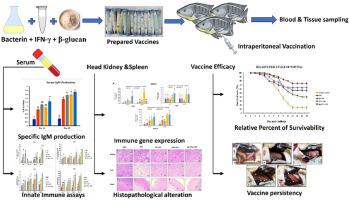干扰素-γ和β-葡聚糖佐剂福尔马林灭活疫苗对尼罗罗非鱼抗迟达爱德华氏菌感染的保护作用
IF 2.4
3区 农林科学
Q1 FISHERIES
引用次数: 0
摘要
水产养殖是中低收入国家的核心商品,也是经济上重要的粮食和生计的有希望的来源。印度水产养殖面临着即将到来的几种鱼类疾病的挑战。延迟爱德华菌(Edwardsiella tarda)感染是影响全球水产养殖的严重威胁之一。疫苗可替代抗生素,作为耐多药迟达杆菌的安全治疗方法。本研究的重点是制备一种含干扰素-γ和β-葡聚糖作为佐剂的福尔马林灭活疫苗,该疫苗可保护尼罗罗非鱼(Oreochromis niloticus)免受迟达芽胞杆菌感染。分离的毒力菌株在海洋营养液中培养,用0.5%福尔马林灭活。为了提高免疫原性,将菌悬液与IFN-γ和β-葡聚糖混合。用IFN-γ和β-葡聚糖佐剂的福尔马林灭活疫苗(FKV)腹腔免疫鱼,然后在固定时间取样。在第一次免疫28天后,以1 × 107 CFU/鱼的剂量对鱼进行攻击。每周采集免疫鱼的血液,测量免疫化学参数,包括氧化钠歧化酶(SOD)、髓过氧化物酶(MPO)、溶菌酶活性(LZM)和杀菌活性。接种后第14天和第28天测定血清IgM滴度值,结果均表明,佐剂接种组的抗体水平高于对照组。IFN-γ和β-葡聚糖免疫组IgM、TCR β、MHCⅱ等免疫基因表达显著升高。该研究强调,β-葡聚糖和IFN-γ佐剂灭活疫苗是可持续水产养殖的新型疫苗接种策略的潜在可行方法。本文章由计算机程序翻译,如有差异,请以英文原文为准。

Protective efficacy of Interferon-γ and β-glucan adjuvanted formalin killed vaccines in Nile tilapia against Edwardsiella tarda infection
Aquaculture is a central commercial commodity for low-to middle-income countries and a promising source of economically important food and livelihood. Indian aquaculture faces challenges with the onset of several upcoming fish diseases. The antimicrobial resistance (AMR) pathogen Edwardsiella tarda infection is one of the serious threats affecting worldwide aquaculture. Replacing antibiotics, vaccines can be used as a safe treatment for multidrug-resistant E. tarda. The present study focuses on creating a formalin killed vaccine incorporated with IFN-γ and β-glucan as adjuvants, that confers protection against E. tarda infection in Nile tilapia (Oreochromis niloticus). The isolated virulent strain was cultivated in marine nutrient broth and inactivated by 0.5 % formalin treatment. To increase the immunogenicity, the bacterial suspension was mixed with IFN-γ and β-glucan. Fish were intraperitoneally immunized with IFN-γ and β-glucan -adjuvanted formalin killed vaccine (FKV), followed by sampling at a fixed time. After 28 days from the first immunization, the fish were challenged with E. tarda at a dose of 1 x 107 CFU/fish. Blood from the immunized fish was sampled weekly to measure immunochemical parameters, including sodium oxide dismutase (SOD), myeloperoxidase (MPO), lysozyme activity (LZM), and bactericidal activity. Fish serum IgM titre values were measured on the 14th and 28 day post-vaccination (d.p.v.), and both showed that the adjuvanted vaccinated groups had higher antibody levels than the control group. The vaccinated groups with IFN-γ and β-glucan showed considerably higher expressions immune genes, including IgM, TCR β, MHC II. The study emphasizes that β-glucan and IFN-γ adjuvanted inactivated vaccine is a potentially plausible approach toward novel vaccination strategies for sustainable aquaculture.
求助全文
通过发布文献求助,成功后即可免费获取论文全文。
去求助
来源期刊
CiteScore
6.20
自引率
6.90%
发文量
206
审稿时长
49 days
期刊介绍:
Developmental and Comparative Immunology (DCI) is an international journal that publishes articles describing original research in all areas of immunology, including comparative aspects of immunity and the evolution and development of the immune system. Manuscripts describing studies of immune systems in both vertebrates and invertebrates are welcome. All levels of immunological investigations are appropriate: organismal, cellular, biochemical and molecular genetics, extending to such fields as aging of the immune system, interaction between the immune and neuroendocrine system and intestinal immunity.

 求助内容:
求助内容: 应助结果提醒方式:
应助结果提醒方式:


